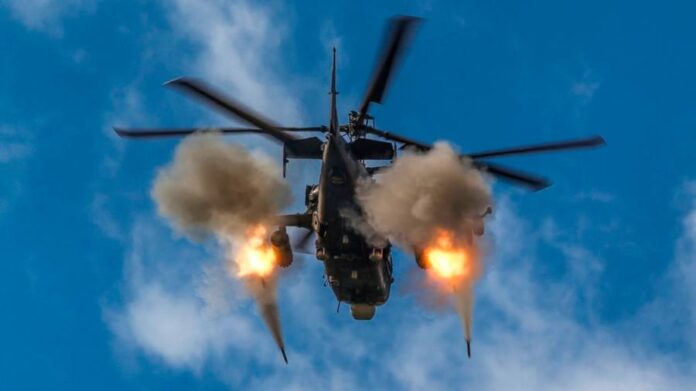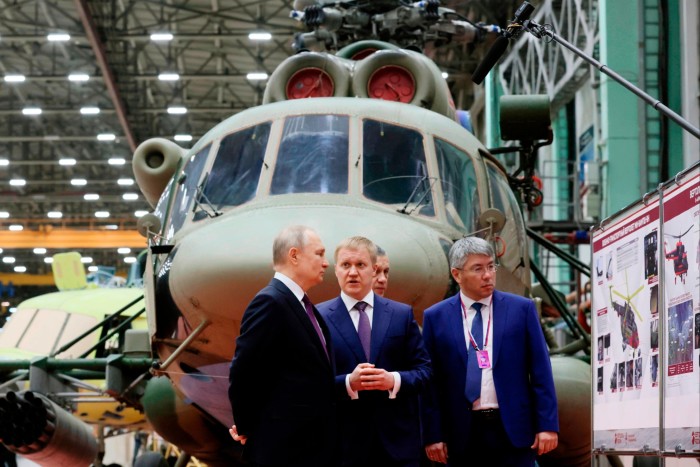Russia’s “dragon teeth” tank traps, minefields and multi-layered fortifications are just one set of obstacles in Ukraine’s budding counteroffensive. Another formidable foe turns out to be airborne, including the Russian Ka-52 “Alligator” attack helicopter.
In one of the campaign’s early battles near Orikhiv, in Zaporizhzhia province, a Ukrainian infantry company drove into a minefield and reportedly came under fire from Alligators, losing several US-supplied Bradley infantry fighting vehicles and a German-built Leopard 2 tank.
It was unclear how many vehicles were destroyed or later recovered. Nor has Kyiv shed light on to how many Ukrainian soldiers were killed. But images of that battle, shared by Russian media and pro-war bloggers, spoke powerfully of the obstacles Ukraine’s forces will have to overcome.
Ukrainian troops and western analysts and officials have long highlighted the role of aviation, including Russian fighter jets and attack helicopters in picking off Ukrainian armour, and the lack of air defences at the frontline to deter them.
“I personally saw how, during our assault, the enemy [fighter jet] aircraft immediately fired on our advancing troops using laser guided bombs from a far distance,” said Stas, a soldier with an elite drone surveillance unit helping infantry regain lost territory in the south of the country. It was not an isolated incident, he said.
Russia’s use of helicopters to attack armour was a “very powerful technique” to which Ukraine had no parity, said Stas, pleading for the west to provide Ukraine with US Apache attack choppers, in addition to F-16 fighter jets.
Ukrainian president Volodymyr Zelenskyy last week paid tribute to his forces for continuing to press into Russian-held territory despite Russia’s “air and artillery superiority”.
Earlier this month, Moscow deployed an additional 20 helicopters including Alligators to an airfield near Berdyansk, 100km from Orikhiv, which has become a leading base for rotary wing operations.
“In the constant contest between aviation measures and countermeasures, it is likely that Russia has gained a temporary advantage in southern Ukraine, especially with attack helicopters employing longer-range missiles against ground targets,” Britain’s defence intelligence tweeted over the weekend.
Despite its technical superiority, Russia’s air force never gained control of Ukrainians skies thanks to Ukraine’s extensive Soviet-era air defences later bolstered by western systems. Russian fighters straying too far over the frontline into Ukrainian territory risked being shot down.
Russian fighter jets and helicopters are now exploiting deficiencies in Ukraine’s air defences at the frontline. Kyiv operates different Soviet-era surface-to-air missile systems, but has too few to provide full cover, leaving it partly reliant on very short-range shoulder-launched missiles (Manpads) which require the operator to see the target before shooting.
“Manpads are not very effective at night,” said a Ukrainian air force pilot. “We need systems with detection and guidance — radar or optical-electronic systems,” the pilot added.
Justin Bronk, senior research fellow at the Royal United Services Institute, a London-based think-tank, said that Russian helicopters fitted with anti tank guided missiles “were always going to be a much greater threat to Ukrainian forces during a counteroffensive than during periods when Ukraine was defending against Russian attacks”.
“They can hover, spot for targets and fire anti-tank guided missiles from beyond the range of shoulder-fired Manpads or anti-aircraft fire,” Bronk said.
This leaves Ukrainian forces having to constantly balance the risk of deploying their scarce surface-to-air missile systems closer to the front lines against the cost of leaving their armoured vehicles exposed to Russian gunfire.
As Russian missile strikes against multiple Ukrainian cities have intensified since early May, Ukraine’s armed forces had to keep their surface-to-air missile systems in place to protect the civilian population rather than moving them to the frontline. The losses in the opening battles of the counteroffensive to Ukrainian forces has set off a rush by western allies to supply additional air defence systems and ammunition to Kyiv.
Britain last week said that together with the US, Denmark and the Netherlands it was purchasing “hundreds of short and medium range air defence systems”, largely Soviet era, to be delivered in the coming weeks.
On Monday, French president Emmanuel Macron announced that Franco-Italian SAMP-T systems pledged earlier were now “operational” in Ukraine.
“The most important problem for Ukraine is that we need to do two air defence tasks simultaneously — to protect major urban areas and industry . . . and the frontline,” said Mykola Bielieskov, a research fellow at the Kyiv-based National Institute for Strategic Studies. “It’s a challenge as we have a shortage of land-based [air defences].” Bieliskov cautioned that those systems could themselves become targets to Russian Lancet kamikaze drones.
The Ka-52 helicopter is hardly infallible. When Russia’s defence ministry broadcast a video of one striking a Leopard tank in an open field, western analysts ascertained the destroyed target was, embarrassingly for Moscow, a crop sprayer.
The Alligator is also highly vulnerable to surface to air missiles when in range. Russia has lost at least 35 of them since February last year, according to Oryx, which documents equipment losses in the war. Colonel Yuriy Ignat, spokesman for the Ukrainian air force, claimed four had been shot down in the last week.
Ignat played down the threat from Russian attack helicopters during the counteroffensive.
“The Ka-52 is absolutely not a helicopter that establishes air superiority,” Ignat said, nor did it deliver “the kind of firepower that is decisive on the battlefield”.
The greater aviation threat to Ukraine’s forces came from Russian fighter jets which had more powerful radars and longer-range missiles than Ukraine’s older Soviet-built aircraft, Ignat said. The vulnerability of Ukrainian forces underscored the need for western-made jets, like the F-16, he said.
Stas, the front drone operator, said Ukraine needed F-16s and US helicopters to protect ground forces.
“Offensive actions require air cover and the most important thing now is the offensive, because if we do not swiftly win this war, if we do not take back all of our territory, it will drag on and on,” he said.
Additional reporting by John Paul Rathbone in London
Credit: Source link
















